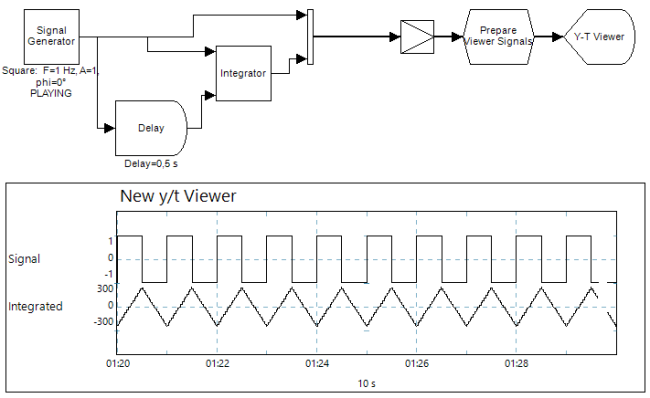 Integrator
Integrator
Overview
Integrates sample values from the S+ input with the sample values of the same channels on the S- input. In other words: values on S+ are added and values on S- are subtracted from the result.Operator ports
Input S+: Floating point valuesInput S-: Floating point values
Output Integral: Floating point values
Properties
Find more information about changing properties here: "Properties Viewer"Caption
type: Word or phraseThe name of the object in the project. This name must not contain '.', '$' nor '@' characters.
For more information about the rules and usage of the Caption property, please refer to "Caption property - background and usage".
Documentation
type: See descriptionOptional documentation of this object. If this object is an operator, the Documentation text is displayed below the operator symbol.
Details
The working of this operator is fairly simple: it contains a value memory (accumulator) for each channel. Each sample that arrives at input S+ is added to the accumulator, and each sample that arrives at the S- input is subtracted from the accumulator.Both inputs must have the same number of channels, otherwise a warning is displayed below the operator symbol.
It is allowed to feed back a signal to one of the inputs that originates from the output.
It is not allowed to directly integrate signals from two different sources. You need to synchronize the signals first, using the "Synchronizer".
The calculation is also performed on constant values (e.g. from a Constant ("K")); either if one of the inputs is a constant or both.
A typical usage of the Integrator is to create a running integral over N seconds, where the window is defined using a Delay operator (set to N seconds delay), as can be seen in the next picture.

For more information, see the example project
Note that all accumulators are re-set to zero in these cases:
- the number of channels at the inputs changes
- a RESET action is performed
- one of the accumulators has an overflow. This happens if the internal value exceeds 1.8 x 10308.
Examples
Example: Integrator example
Simple demonstration of the Integrator operator. Using the Delay it is easy to make an integration with a running window with the length as set in the Delay operator.Because the sample rate of the Signal Generator is 500 samples/sec, the square is a signal of 1 Hz, and the Delay is set to 0.5 seconds, the triangle (running integral of the square) has an amplitude of 500.
Examples\DF0204029_001_Integrator_Demo.xmc
